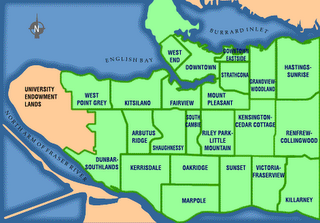
(Nov 2010: Revised many grammatical errors. This just shows how tipsy I was after returning from the main event and the bar session afterwards.)
My first impression of him, who replaced Larry Beasley as the new Director of Planning for the City of Vancouver, at the evening session of the Higher Learning Symposium yesterday (October 19, 2006) was, "Man, he is very young." I am guessing he is between the ages of 30-35. His appointment shows that decision-makers at Cambie and 12th want a young, energetic leader who is open to different ideas and options. With his background on densifying suburban Calgary, it is expected that similar endeavors will be taken in the "suburban" areas of Vancouver such as Victoria and 41st, the Kingsway Corridor, and Kerrisdale. In fact, intensification efforts can be seen at the intersection of Kingsway and Knight St. before Beasley retired. Planners in City Hall and developers need to look for opportunities outside the prized downtown area, even though land is still available in adjacent areas to the east (namely Downtown Eastside, Chinatown, Strathcona, and the False Creek Flats). It will be interesting to see how Brent can emerge out of the shadows of his predecessor, who in my opinion is highly influential in turning the Downtown Peninsula into the livable, pedestrian-oriented mecca we see today.
With that aside, the evening session on tall buildings in Downtown Toronto was informative and eye-opening. Being a person who is very new to the city, I was surprised to see the high levels of opposition to towers in Toronto in the name of neighbourhood conservation. I disagreed with our faculty's former director of the planning program, who was one of the panelists, when she suggested that high-rises resemble nothing but erect penises soaring out of nowhere. (What should we do to counter this "bad" trend? Building lots of buildings that look like vaginas?)
I also have to disagree with the speaker for the development community she claimed that the sector will not profit if it doesn't construct tall buildings. Fortunately, this comment was quickly countered by Paul Katz, a well-known architect on mega-structures, saying that medium-rise buildings are needed to create a gradual increase in building height (and therefore creating an attractive urban skyline).
Here is my take on this issue in Toronto. Before the advent of the modern transportation systems, the now-inner-city areas such as Rosedale, Queen West, Cabbagetown, etc. were originally viewed as the edges of the city. The craze for cars and freeways after the end of WWII redefined the traditional urban boundaries. When the problems of sprawl began to be taken seriously, the talk centred around the need to concentrate people and jobs once again at city centres (ie, a return to inner-cities). Regrettably, we are seeing opposition from these traditional neighbourhoods (with a streetcar system that is saved from destruction and envied by cities across North America). The residents must realize that, despite the equal importance of retaining neighbourhood integrity, they will have to accept densification measures in order to combat suburban sprawl. They cannot simply look at the issue through the lens of their immediate surroundings; they have to also view it as a region-wide issue. It doesn't hurt to have a mixed stock of housing in terms of age and height, similar to Vancouver's West End neighbourhood.
 Yonge Street South of Eglinton Avenue
Yonge Street South of Eglinton Avenue The class before we head off. (Thank you Paul Bedford -- instructor and former Director of Planning for Toronto -- for taking the pic)
The class before we head off. (Thank you Paul Bedford -- instructor and former Director of Planning for Toronto -- for taking the pic)
 Yonge and Davisville. The blue building was converted from commercial to residential use in the early 1990s as a result of reduced demand for office space.
Yonge and Davisville. The blue building was converted from commercial to residential use in the early 1990s as a result of reduced demand for office space.


